Feudal Chess
An intense middle ages clash of massive
proportions.
Inventor:
Rupert
Hickton.
Background
Feudal
chess had its beginnings in 1997. Pieces
were designed and professionally turned at this time to be compatible with Staunton pieces. The new piece movements were chosen to be
either similar to chess pieces, or easy to conceptualise. This was to help players adapt to the game
more easily. The concept was played and fine tuned until March 2005 when the
final concept was chosen. The game has been
played by 5 people over this time who enjoyed the game and suggested further publication.
Introduction
Feudal
Chess is a 12x10 themed chess with variable armies variant. The term variable armies was selected (as opposed
to different armies) because the
opposing armies may or may not share similar pieces. Feudal Chess incorporates all the 16 pieces
in a Chess army and introduces 4 new starting pieces (selected from a pool of
9) played on a 12 x 10 board. There are 15 or more balanced configurations (combinations)
of feudal pieces so that the game is even.
The
Pieces
Standard
pieces:
| Piece | Abv. | Value | Movement |
|---|
| Queen | Q | 10 | R + B |
| Rook | R | 6 | orthogonally |
| Bishop | B | 4 | diagonally |
| Knight | N | 2.5 | 2r opposite colour |
| Pawn | P | 1 | see notes |
Note: values of standard pieces are adjusted because of larger board size.
Feudal pieces:
| Piece | Abv. | Value | Movement |
|---|
| Prophet | O | 23 | 1r, 2r, 3r |
| Pontiff | F | 13 | Q + N |
| Siege Weapon | W | 9 | A + B |
| Duke | D | 9 | R + N |
| Seer | S | 9 | 1r, 2r |
| Archer | A | 5 | 3r opposite colour |
| Cavalier | C | 5 | N + 3 sq. diag. jump |
| Prelate | L | 5 | B + K |
| Guard | G | 2 | see notes |
Note:
r stands for radius
Configurations
|
Configurations
|
Starting
Squares
|
|
ORTHODOX
|
1
|
2
|
3
|
4
|
|
Royal
|
Pontiff
|
Duke
|
Cavalier
|
Archer
|
|
French
|
Pontiff
|
Duke
|
Cavalier
|
Prelate
|
|
English
|
Pontiff
|
Duke
|
Archer
|
Prelate
|
|
|
|
|
|
|
|
HETERDOX
|
|
Anathema
|
Pontiff
|
Seer
|
Cavalier
|
Archer
|
|
Apostate
|
Pontiff
|
Seer
|
Cavalier
|
Prelate
|
|
Schism
|
Pontiff
|
Seer
|
Archer
|
Prelate
|
|
|
|
|
|
|
|
ZEALOT
|
|
Conquest
|
Pontiff
|
S.Weapon
|
Cavalier
|
Archer
|
|
Crusade
|
Pontiff
|
S.Weapon
|
Cavalier
|
Prelate
|
|
Jihad
|
Pontiff
|
S.Weapon
|
Archer
|
Prelate
|
|
|
|
|
|
|
|
CAMPAIGN
|
|
Battle
|
S.Weapon
|
Duke
|
Seer
|
Cavalier
|
|
War
|
S.Weapon
|
Duke
|
Seer
|
Prelate
|
|
Siege
|
S.Weapon
|
Duke
|
Seer
|
Archer
|
|
|
|
|
|
|
|
DOOMS
DAY
|
|
Apocalyptic
|
Prophet
|
Cavalier
|
Guard
|
Guard
|
|
Oblivion
|
Prophet
|
Archer
|
Guard
|
Guard
|
|
Redemption
|
Prophet
|
Prelate
|
Guard
|
Guard
|
The
Setup
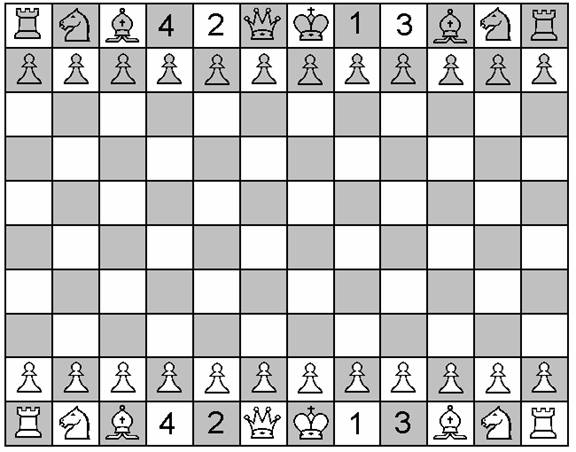
The
numbers 1, 2, 3 and 4 are the starting squares for the feudal pieces.
Piece
Movement & Explanation:
Prophet:
Captures the 1st, 2nd and 3rd radius.

Prophets
were able to sway masses of people to follow them because God had spoken to
them. They usually founded an entire religion and wielded enormous power for
people to do their will.
Pontiff:
Queen + Knight

A
pontiff was the head of an entire Religion and usually thought to be the
successor of the Prophet. His power
overruled the monarchy of a country where that religion was established. The citizens had to follow the pontiff over
their own king. Kings also had to follow the authority of the
Pontiff or dire consequences could follow.
Siege
Weapon: Bishop + Archer
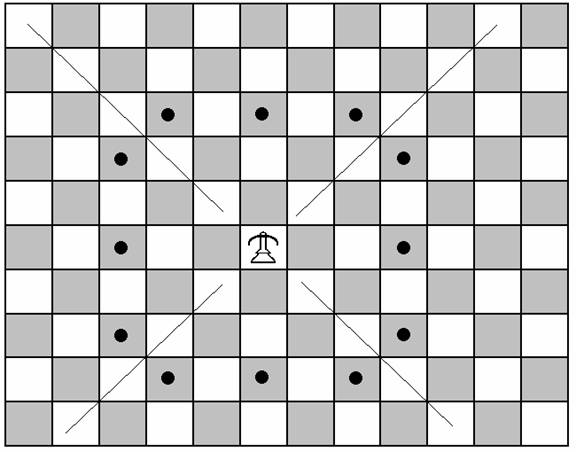
A
siege weapon was a valuable tool in any campaign. The defences of the enemy could be easily
breached and the sight of such weapons would bring dread and despondency in any
foe.
Duke:
Rook + Knight
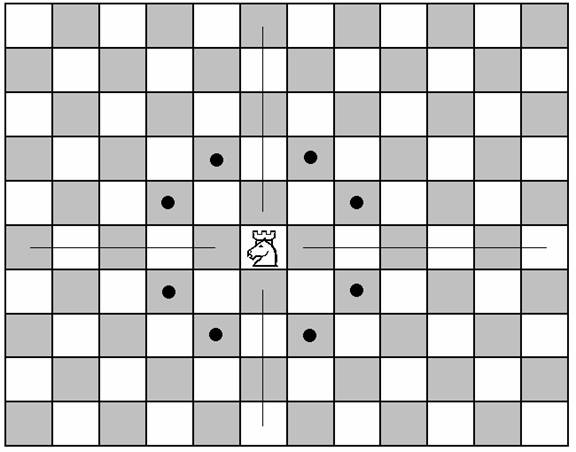
A
duke was the highest ranking nobleman next to a king or prince. He was usually the owner of large areas of
land and had significant military capability.
In battle the duke would be a valuable asset because of his tactical
knowledge, resources and leadership.
Seer:
Captures the 1st and 2nd radius.

A
seer had the ominous ability to foresee future events making him very useful in
conflicts. The distinction between him
and the prophet was that he did not have an army of religious zealots who were
prepared to die for his cause.
Archer:
Hit 3rd
radius, opposite colour to original square.
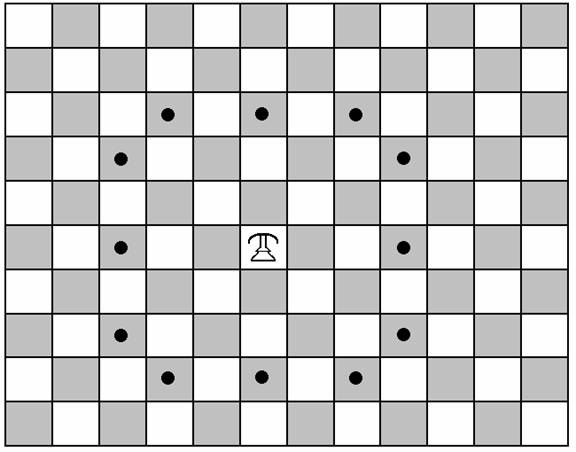
Archers
were useful in softening up the enemy before an assault. They had range and could strike from some
distance. The best way to conceptualise
the striking squares of the archer is to think of the third radius and the opposite
colour to which it is on.
Prelate:
Bishop + King
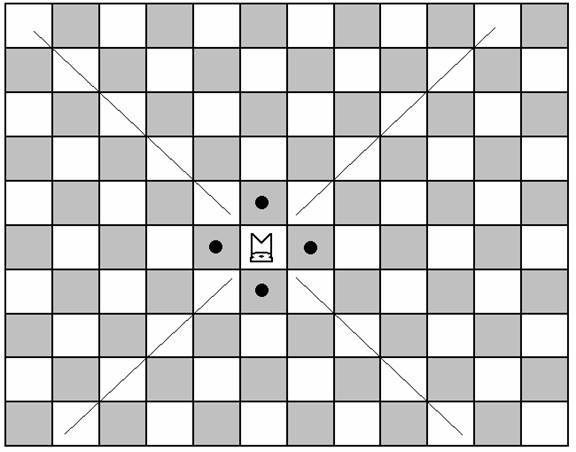
Prelates
include bishops of higher rank such as arch-bishops, cardinals and
primates. They were often the top
ranking bishop of a nation and were not so limited to the affairs of their own
dioceses. They could more easily sway
the nations opinions and beliefs and therefore its forces as well. The prelate is a bishop with capability on
both black and white squares.
Cavalier:
Knight + 3rd radius corners (3 square diagonal hop)
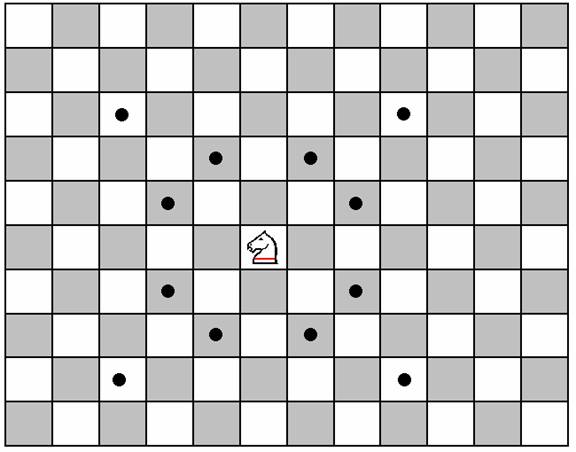
Cavaliers
were knights of distinction. They were
not only great soldiers but had greater influence because of their education
and connections. The cavalier has a
significant increase in ability and range to mirror this. A cavalier is a knight with red markings.
Guard:
1 diagonal, 2 square orthogonal jump,

A
palace or royal guard was sometimes selected from the foot soldiers because of
greater combat skill and loyalty to the king.
These arch pawns are useful in hindering the enemies assault and have
the ability to queen.
Rules
of Feudal Chess
The
rules are the same as chess with the following exceptions:
Pawn Movement:
Pawns
may move up to 3 squares on the first move and then up to two from then
on. The en passant move will be more common because of a pawns ability to
move 2 squares at any time.
Promotion:
Pawns
and Guards may promote to any piece other than the Prophet or Pontiff that are
not currently present on the board.
Castling:
Castling
may occur on either side as in normal chess.
The rook can be placed on 3, 4 or 8, 9 (on queens side). The king can castle when obstructed by feudal
pieces by passing over them. The King
cannot castle when the bishop or knight are in their start position.
Choosing a configuration:
The
configuration is written down before being announced.
Feudal
Chess Additions:
Additional
Configurations: (Gauntlet, Judgement Day)
Piece Abv. Value Movement
Dragon D 23 1 or
2 N moves
Champion M 9 C + 4
square
orthogonal hop.
|
GAUNTLET
|
|
Feat
|
Pontiff
|
Champion
|
Cavalier
|
Archer
|
|
Quest
|
Pontiff
|
Champion
|
Cavalier
|
Prelate
|
|
Trial
|
Pontiff
|
Champion
|
Archer
|
Prelate
|
|
JUDGEMENT
DAY
|
|
Armageddon
|
Dragon
|
Cavalier
|
Guard
|
Guard
|
|
Cataclysmic
|
Dragon
|
Archer
|
Guard
|
Guard
|
|
Insurrection
|
Dragon
|
Prelate
|
Guard
|
Guard
|
The
Champion can also be inserted into any of the CAMPAIGN configurations at the
expense of a 9 point piece.
Champion:
Cavalier + 4 square orthogonal hop.

A
champion was the undisputed first knight of the realm and answerable to the
king or queen directly. He had proven
himself in combat against enemies and in sparing contests against his
peers. A champion is a knight with gold
markings.
Dragon:
1 or 2 Knight Moves
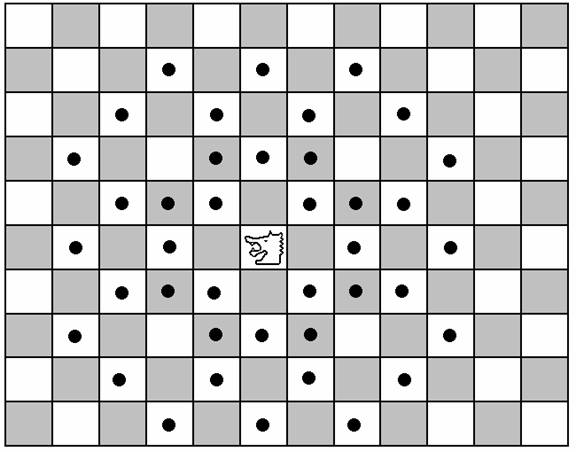
A mythological creature of astounding strength.
Feudal
Summons Variation
The
cavaliers can summon knights to any attacking square as a move. Prelates can summon bishops to any attacking
square. Dukes can summon rooks and knights to respective squares. Pontiffs can
summon prelates and bishops to respective squares.
Feudal
Honours Variation
After
3 captures, Knights are promoted to Cavaliers.
|
Piece
|
Captures
|
Promoted
|
|
Knight
|
3
|
Cavalier
|
|
Cavalier
|
3
|
Champion
|
|
Bishop
|
3
|
Prelate
|
|
Pawn
|
2
|
Guard
|
|
Guard
|
2
|
Knight
|
|
Rook
|
3
|
Duke
|
|
Archer
|
3
|
Siege
Weapon
|
|
LEIGE
|
1
|
2
|
3
|
4
|
|
Summons
|
Pontiff
|
Prelate
|
Cavalier
|
Archer
|
|
Honours
|
Pontiff
|
Prelate
|
Cavalier
|
Archer
|
|
Valour
|
Duke
|
Prelate
|
Cavalier
|
Archer
|
The
Valour configuration combines both Summons and Honours abilities into one
army. All LEIGE configurations have been
deducted material strength so they can be played against other configurations.
Acknowledgement
The Chess Variant Web team.
David Howe for his Alfaerie chess
graphics.
Contact












